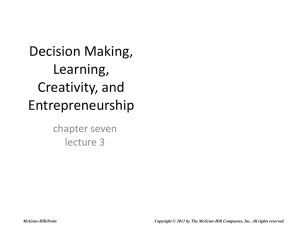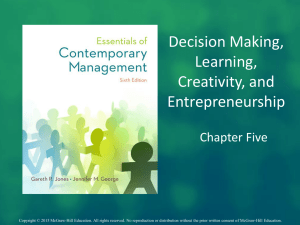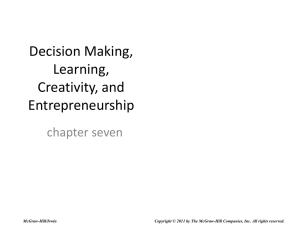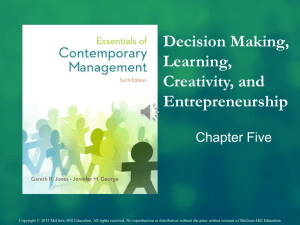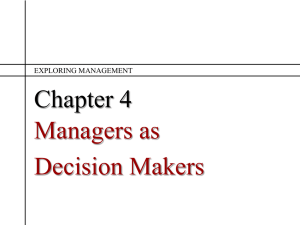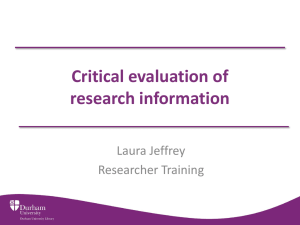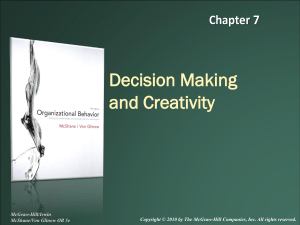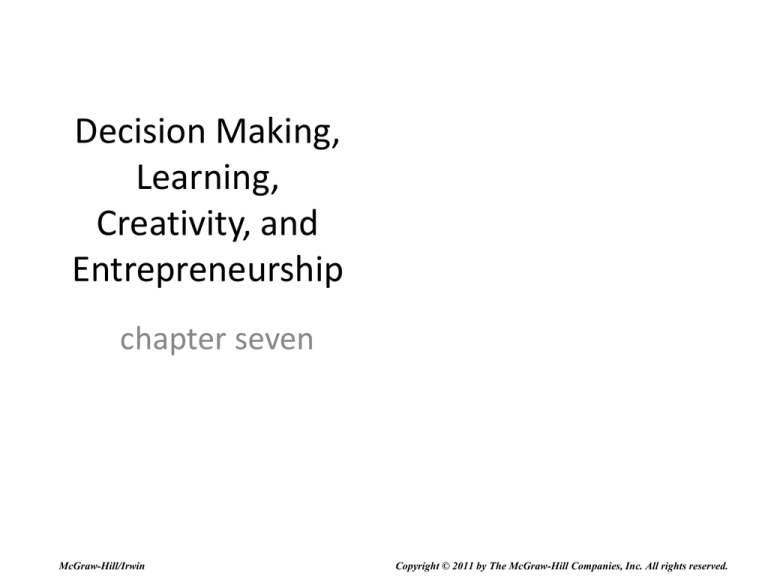
Decision Making,
Learning,
Creativity, and
Entrepreneurship
chapter seven
McGraw-Hill/Irwin
Copyright © 2011 by The McGraw-Hill Companies, Inc. All rights reserved.
Learning Objectives
1. Understand the nature of managerial decision
making, differentiate between programmed
and non-programmed decisions, and explain
why non-programmed decision making is a
complex, uncertain process.
2. Describe the six steps that managers should
take to make the best decisions and explain
how cognitive biases can lead managers to
make poor decisions.
7-2
Learning Objectives
3. Identify the advantages and disadvantages of group
decision making, and describe techniques that can
improve it.
4. Explain the role that organizational learning and
creativity play in helping managers to improve their
decisions.
5. Describe how managers can encourage and
promote entrepreneurship to create a learning
organization and differentiate between
entrepreneurs and intrapreneurs
7-3
The Nature of Managerial
Decision Making
• Decision Making
– The process by which managers respond to
opportunities and threats that confront them by
analyzing options and making determinations
about specific
organizational
goals and courses
of action.
7-4
The Nature of Managerial
Decision Making
• Decisions in response
to opportunities
• Decisions in response
to threats
– occurs when managers
respond to ways to
improve organizational
performance to benefit
customers, employees,
and other stakeholder
groups
– events inside or outside
the organization are
adversely affecting
organizational
performance
7-5
Decision Making
• Programmed Decision
– Routine, virtually automatic process
• Decisions have been made so many times in the
past that managers have developed rules or
guidelines to be applied when certain situations
inevitably occur
7-6
Decision Making
• Non-Programmed Decisions
– Nonroutine decision making that occurs in
response to unusual, unpredictable opportunities
and threats
• Rules do not exist because the situation is
unexpected or uncertain and managers lack the
information they would need to develop rules to
cover it.
7-7
Decision Making
• Intuition
• Reasoned judgment
– feelings, beliefs, and
hunches that come
readily to mind, require
little effort and
information gathering
and result in on-the-spot
decisions
– decisions that take time
and effort to make and
result from careful
information gathering,
generation of
alternatives, and
evaluation of
alternatives
7-8
The Classical Model
• Classical Model of Decision Making
– A prescriptive model of decision making that
assumes the decision maker can identify and
evaluate all possible alternatives and their
consequences and rationally choose the most
appropriate course of action.
7-9
The Classical Model
• Optimum decision
– The most appropriate decision in light of what
managers believe to be the most desirable future
consequences for their organization.
7-10
The Classical Model of Decision
Making
Figure 7.1
7-11
The Administrative Model
• Administrative Model
– An approach to decision making that explains why
decision making is inherently uncertain and risky
and why managers usually make satisfactory
rather than optimum decisions.
7-12
The Administrative Model
• Bounded rationality
• Incomplete information
– Cognitive limitations that
constrain one’s ability to
interpret, process, and
act on information.
– Because of risk and
uncertainty, ambiguity,
and time constraints
7-13
Why Information Is Incomplete
Figure 7.2
7-14
Causes of Incomplete Information
• Risk
– The degree of probability that the possible
outcomes of a particular course of action will
occur.
• Uncertainty
– the probabilities of alternative outcomes cannot
be determined and future outcomes are unknown
7-15
Causes of Incomplete Information
• Ambiguous Information
Young Woman or Old
Woman
– Information that can be
interpreted in multiple
and often conflicting
ways.
7-16
Figure 7.3
Causes of Incomplete Information
• Time constraints and information costs
– managers have neither the time nor money to
search for all possible alternatives and evaluate
potential consequences
• Satisficing
– Searching for and choosing an acceptable, or
satisfactory response to problems and
opportunities, rather than trying to make the best
decision
7-17
Six Steps in Decision Making
Figure 7.4
7-18
General Criteria for Evaluating Possible
Courses of Action
Figure 7.5
7-19
Feedback Procedure
1. Compare what actually happened to what
was expected to happen as a result of the
decision
2. Explore why any expectations for the
decision were not met
3. Derive guidelines that will help in future
decision making
7-20
Cognitive Biases and Decision Making
• Heuristics
– Rules of thumb that simplify the process of
making decisions.
• Systematic errors
– errors that people make over and over and that
result in poor decision making
7-21
Sources of Cognitive Biases
• Prior Hypothesis Bias
– A cognitive bias resulting from the tendency to
base decisions on strong prior beliefs even if
evidence shows that those beliefs are wrong.
• Representativeness
– A cognitive bias resulting from the tendency to
generalize inappropriately from a small sample or
from a single vivid event or episode.
7-22
Sources of Cognitive Biases
• Illusion of Control
– The tendency to overestimate one’s own ability to
control activities and events.
• Escalating Commitment
– A source of cognitive bias resulting from the
tendency to commit additional resources to a
project even if evidence shows that the project is
failing.
7-23
Group Decision Making
• Superior to individual making
• Choices less likely to fall victim to bias
• Able to draw on combined skills of group
members
• Improve ability to generate feasible
alternatives
7-24
Group Decision Making
• Potential Disadvantages
– Can take much longer than individuals to make
decisions
– Can be difficult to get two or more managers to
agree because of different interests and
preferences
– Can be undermined by biases
7-25
Group Decision Making
• Groupthink
– Pattern of faulty and biased decision making that
occurs in groups whose members strive for
agreement among themselves at the expense of
accurately assessing information relevant to a
decision
7-26
Devil’s Advocacy and Dialectical
Inquiry
Figure 7.7
7-27
Organizational Learning and Creativity
• Organizational learning
– Managers seek to improve a employee’s desire and
ability to understand and manage the organization
and its task environment so as to raise effectiveness.
• Learning organization
– An organization in which managers try to maximize
the ability of individuals and groups to think and
behave creatively and thus maximize the potential for
organizational learning to take place.
7-28
Organizational Learning and Creativity
• Creativity
– The ability of the
decision maker to
discover novel ideas
leading to a feasible
course of action.
7-29
Senge’s Principles for Creating a
Learning Organization
Figure 7.8
7-30
Building Group Creativity
• Brainstorming
– Managers meet face-to-face to generate and
debate many alternatives.
• Production Blocking
– Occurs because group members cannot
simultaneously make sense of all the alternatives
being generated, think up additional alternatives,
and remember what they were thinking
7-31
Building Group Creativity
• Nominal Group Technique
– A decision making technique in which group
members write down ideas and solutions, read
their suggestions to the whole group, and discuss
and then rank the alternatives.
• Useful when an issue is controversial and when
different managers might be expected to
champion different courses of action
7-32
Building Group Creativity
• Delphi Technique
– A decision-making technique in which group
members do not meet face-to-face but respond in
writing to questions posed by the group leader.
7-33
Entrepreneurship
• Entrepreneurs
– Individuals who notice opportunities and take the
responsibility for mobilizing the resources
necessary to produce new and improved goods
and services.
• Social entrepreneurs
– those who pursue initiatives and opportunities to
address social problems and needs in order to
improve society
7-34
Entrepreneurship
• Intrapreneurs
– A manager, scientist, or researcher who works
inside an organization and notices opportunities
to develop new or improved products and better
ways to make them.
7-35
Characteristics of Entrepreneurs
• Open to experience: they are original thinkers
and take risks.
• Internal locus of control: they take
responsibility for their own actions.
• High self-esteem: they feel competent and
capable.
• High need for achievement: they set high
goals and enjoy working toward them.
7-36
Entrepreneurship and Management
• Frequently, founding entrepreneur lacks the
skills, patience, and experience to engage in
the difficult and
challenging work
of management
7-37
Intrapreneurship and
Organizational Learning
• Product champions
– taking ownership of a product from concept to
market.
• Skunkworks
– keeping a group of intrapreneurs separate from
the rest of the firm.
• Rewards for innovation
– linking innovation by workers to valued rewards.
7-38

